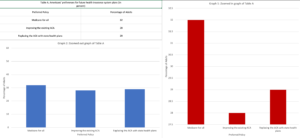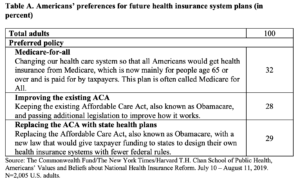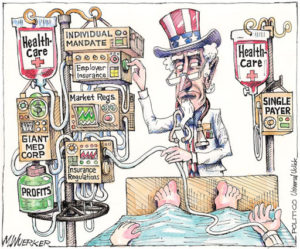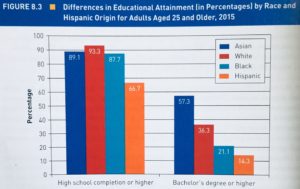The Individual
With the human population reaching an all-time high of 7.8 billion, individual efforts have never felt more meaningless. However, the founding fathers of America disagree. After all, why did the fathers include the right of free speech as the first amendment in the Bill of Rights, if they believed that individual opinion made no difference? Individual opinions and actions DO make a difference. They can even prompt changes at the local and national levels in a process that can be broken down into four steps. First, an individual must identify a problem and then proceed to act toward solving the problem. These individual actions can vary from joining an organization that supports the cause to raising awareness on social media. As awareness rises, local institutions will join the movement and attempt to implement the suggested solution on a small scale. Eventually, local institutions will grow and band together to make a united appeal for action at the national level. This process of change is currently taking place for the healthcare of the United States.

First off, it is important to highlight why the current healthcare system needs fixing. The problem with the health care system of the United States is that it is based on the ‘cooperation’ of different policies, which decreases the effectiveness of the care delivered and hikes costs. To clarify, Americans can receive health insurance from their jobs, personal expenses, the Affordable Care Act, Medicare, and Medicaid. This leaves out around 28 million people that were still uninsured as of 2018 according to the census taken that year because the United States is the only developed country without mandatory health insurance (1). Overall, the United States uses up 17.7 percent of the Gross Domestic Product (G.D.P.) to maintain this system which is more than any other developed country. In essence, the healthcare system of the United States is in dire need of change.

In order for healthcare to improve, action/change must start at the individual level. Individuals that identify the troubled healthcare system must first conduct a small study concerning the proposed policies and the parties that proposed them. One example of these proposed policies is single-payer healthcare, which describes a method of financing healthcare by taking a portion of everybody’s income instead of premiums to provide universal healthcare and wide coverage. Another fact that individuals should keep in mind is that often several plans will be combined tp better suit the needs of the people. Technically, both Britain and Canada have single-payer systems that cover all, but Canada relies on private companies to deliver care while Britain delivers the care and regulates drug costs. This miniature study should help individuals make informed decisions when voting for candidates that propose different healthcare plans. Furthermore, understanding the different policies will aid individuals to publicize accurate information on social media platforms and will enable them to spot misinformation. Moreover, individuals can choose to join organizations that advocate for their ideal medicare system and write encouraging letters to representatives. Currently, the biggest supporter of single-payer healthcare is Bernie Sander, and individuals can support his campaign on his website (2). In brief, individuals should start their attempts to fixing healthcare by conducting a study and then proceeding to act in support of the policy they prefer.

As more individuals move to action, local institutions respond to the increasing interest according to the resources available to them. In other words, colleges could conduct surveys or studies on the effectiveness of single-payer healthcare and the public demand for this system. Furthermore, colleges can offer occasional seminars that explain the current system and the alternative systems available. While conducting these seminars, colleges should not choose a system but spread accurate information about all the systems to enable college students to make their own informed decisions about the best fix for healthcare. Colleges could also allow student clubs that keep their members posted about the latest developments concerning healthcare and organize various events to raise donations for hospitals that provide services to the uninsured and needy. Unfortunately, local businesses might struggle to participate in fixing healthcare. One solution for this is for employers to include a detailed explanation of healthcare alongside the insurance coverage they normally provide to their employees. While the response of local institutions may vary, eventually the demand will drive proposals onto the national stage.

Arguably, the last step towards reform can be the most challenging one as officials debate various plans competing for adoption. As the debates begin, the government must make sure that the public is aware of the nature of the plans being discussed. A perfect example of a healthcare debate can be found in a unique article titled “Universal New York Health Care: A Single-Payer Strategy Linking Cost Control and Universal Access” by Doctor Dan E. Beauchamp and Professor Ronald L. They review three different proposals to improve the Healthcare system of the United States. The three proposals discussed were the Physicians for a National Health model, Enthoven and Kronick’s sponsor-based competitive model, and the Universal New York Health Care model. Enthoven and Kronick’s proposal relies on cost-competitive employment-based insurance and provides subsidized insurance for the unemployed. On the other hand, the proposal of the Physicians for a National Health Program is based on the Canadian plan and replaces private health insurance with a tax-based system led by the federal government. After introducing these two major proposals, Doctor Dan E. Beauchamp and Professor Ronald L. Rouse shifted focus to the Universal New York Health Care proposal or UNY-Care9 that takes aspects from the aforementioned two systems and is their personal favorite. The UNY-Care9 retains the system of private and public insurance. However, the private insurance system will be restructured to aid in the fight against medical inflation and reduce paperwork costs by adopting a one-card system of membership between providers and payers. This will result in health care benefits becoming more uniform for all American citizens. Furthermore, the government will pay insurance companies with founds from a one-payer financing structure. Personally, UNY-Care9 seems to be the perfect plan for introducing single-payer healthcare to the United States as it keeps the existing private insurers while introducing the many benefits of single-payer healthcare. Nevertheless, all three of the aforementioned proposals are valid and the authors of the article do an excellent job of explaining them to the reader. This is achieved by clearly explaining the basis on which each system is constructed and the financing system that each proposal will rely on (3). Overall the last step of the change process takes place on the national stage and the government must be transparent with its citizens concerning the policies being discussed.
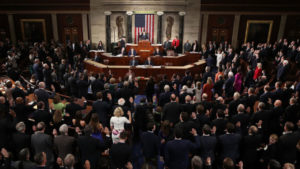
While it is important to celebrate the passing of legislation aimed at improving the current healthcare system, it is more essential to remember that the achievement would not be possible without the action of individuals nationwide. In other words, what is truly commendable is the courage and effort of individuals who decided to band together to fix a broken system. Furthermore, help that local institutions provide to a movement in the form of research or information is worth of honorable mention as well. Of course, movements differ in their progression through the three steps, but these steps are a reminder of what matters most, in the long run, the individual.
Footnotes:
1.US Census Bureau. “Health Insurance Coverage in the United States: 2018.” The United States Census Bureau, November 8, 2019. https://www.census.gov/library/publications/2019/demo/p60-267.html.
2.https://berniesanders.com/issues/medicare-for-all/
3.Beauchamp, Dan E., PhD. and Ronald L. Rouse M.P.A. “Universal New York Health Care: A Single-Payer Strategy Linking Cost Control and Universal Access.” The New England Journal of Medicine 323, no. 10 (Sep 06, 1990): 640-644. doi:http://dx.doi.org.library2.ramapo.edu:2048/10.1056/NEJM199009063231005. http://library.ramapo.edu:2048/login?url=https://search-proquest-com.library2.ramapo.edu:2443/docview/1983427945?accountid=13420.










